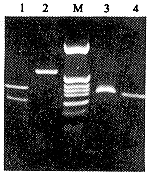聚合酶链反应酶谱分型检测宫颈癌中人乳头瘤病毒和单纯疱疹病毒
中华实验和临床病毒学杂志 1999年第3期第13卷 论著
作者:李连青 朱庆义 郑曙民
单位:李连青 朱庆义 (030013 太原 山西省儿童医院分子微生物室);郑曙民 (山西省肿瘤医院)
关键词: 宫颈癌;人乳头瘤病毒;单纯疱疹病毒;PCR-酶谱分型
【摘要】 目的 探讨人乳头瘤病毒(HPV)和单纯疱疹病毒(HSV)等对宫颈癌的病因学作用。方法 应用聚合酶链反应(PCR)-核酸内切酶分型检测宫颈癌活检组织中HPV-DNA和HSV-DNA基因,以正常宫颈组织作对照。结果 在宫颈癌活检组织中HPV-16,18型和HSV-2型阳性率分别为38.9%和34.6%,与正常妇女宫颈组织阳性率均为3.2%比较,差异均有非常显著意义(P<0.001)。结论 HPV-16,18型和HSV-2型是诱发宫颈癌的重要病原因子。
Detection of human papillomavirus and herpesvirus genotypes in biopsy specimens from cervical carcinoma by PCR-endonuclease cleavage
LI Lianqing*, ZHU Qingyi, ZHENG Shumin.
(Lab.Molecular Microbiology, Shanxi Children′s Hospital, Taiyuan, 030013)
【Abstract】 Objective This study was to detect the human papillomavirus (HPV) and herpes simplex virus (HSV) genotypes in biopsy specimens of cervical carcinoma and genital verruca by PCR-endonuclease cleavage.Methods Biopsy samples of were obtained from 390 patients with cervical carcinoma,HPV and HSV genotypes were detected by PCR and endonuclease cleavage.Results The results indicated that HPV types 16, 18, 35 were found in 152 (38.9%) of 390 cervical carcinoma, in 56 (31.8%) of 176 cervical erosion, while HPV types 6, 11 were found in 80 (58.8%) of 136 acuminate erruca. The HSV-2 type were found in 135 (34.6%) of 390 cervical carcinoma and in 33 (18.7%) of 176 cervical erosion. The HPV 16, 18, 35 types and HSV-2 type found in normal cervical secretions of the control group all were 3.2%, There was significant difference between the test group of cervical carcinoma and the control group of normal cervical secretion (P<0.001 by ×2 analysis). The restriction endonuclease analysis of these amplified products showed that positive rates of HPV 16, 18, 35 types and HSV-2 type from cervical carcinoma were 23.3%, 14.6%, 1.0% and 34.6% , respectively. While HPV 6, 11 types from acuminate verruca were 36.0% and 22.8% positive respectively.Conclusion The results suggest that HPV 16, 18 types and HSV-2 type are associated with majority of the cervical carcinoma.
【Key words】 Cervical carcinoma Human papillomavirus Herpes simplex virus PCR-endonuclease cleavage
近年来随着分子生物学技术在肿瘤病原病因学研究中应用,发现单纯疱疹病毒(HSV)-2型和人乳头瘤病毒(HPV)是引起妇女生殖器疣和诱发宫颈癌的重要病原之一[1~4]。我们应用聚合酶链反应(PCR)-酶谱分型对宫颈癌和尖锐湿疣等妇女生殖器细胞增生性病变作了病毒病原学探讨研究,报告如下。
1 材料和方法
1.1 标本来源 1993年6月~1997年12月,在山西省肿瘤医院,山西省妇幼保健院,太原市中心医院妇产科住院和门诊病人。临床诊断为宫颈癌390例,尖锐湿疣136例,取宫颈活检组织;宫颈糜烂176例,取宫颈分泌物;对照组为94例正常妇女,取宫颈分泌物。于1 ml磷酸盐缓冲液中,-30℃保存。
1.2 引物合成 HPV-2(16、18、35)和HSV-1、2型引物由本室自行设计,中国科学院微生物学研究所协助合成;HPV-Ⅰ(6、11型)和HHCE(包括HSV-1、HSV-2,人巨细胞病毒和EB病毒4种疱疹病毒)引物由军事医科院微生物流行病学研究所和空军总医院临床分子生物学研究中心提供。HPV-Ⅱ(16,18,35型)引物:基因序列位于L1区,扩增产物HPV16/18型为676 bp,HPV-35型为670 bp,引物序列如下:上游引物序列为5′-TTAGGTGTTGGCCTTAGTGG-3′,下游引物序列为5′-GAGTGGTATCTACCACAGTAA-3′。HSV引物:基因序列位于DNA聚合酶基因区,设计了3条引物,扩增产物HSV-1为362 bp, HSV-2为374 bp,序列如下:HSV-1上游引物序列为5′-GACGAGGACGAACGCGAGGA-3′,HSV-2上游引物序列为5′-GACGAGGATAAGGACGACGACG-3′,HSV-1/2共同下游引物序列为5′-GAGCGGATCTGCTTTCGCAT-
3′。
1.3 DNA模板提取 取活检组织约3 mm3于100 μl盐水中捣碎,宫颈分泌物离心后取沉淀物100 μl,加2XPCR蛋白酶-K裂解液100 μl(P-K酶200 μg/ml),60℃1小时,煮沸10分钟,离心沉淀,取上清液作PCR。
1.4 PCR程序 于0.5 μl反应管中分别加PCR反应混合液10 μl,DNA模板提取液15 μl,置扩增仪中。93℃预变性3分钟,进入循环,93℃1分钟、58℃1分钟、72℃1分钟,共30周期,最后72℃延伸5分钟。用1.5%琼脂糖凝胶电泳(含EB0.5 μg/ml),紫外检测仪观察结果。所有临床标本均先用HPV-Ⅰ,HPV-Ⅱ,和HHCE多基因引物作PCR试验筛查,阳性者再用酶切分型鉴定。
1.5 酶切分型 HPV-DNA阳性扩增产物用限制性核酸内切酶作酶切分型鉴定。HPV-6型产物用Taq1酶切成130 bp和254 bp; HPV11型酶切后仍为一条384 bp区带;HPV-16型产物用BamH I酶切成178 bp和498 bp;HPV-18型产物用PstⅠ酶切成377 bp和299 bp;HPV-35型产物用DdeⅠ酶切成380 bp和290 bp。HHCE-DNA阳性者分别用HSV-1和HSV-2作分型测定,扩增产物用TaqⅠ核酸内切酶作酶切分型鉴定,HSV-1型酶切成140 bp和222 bp,HSV-2型酶切成110 bp和264 bp。
2 结果
2.1 临床标本PCR检测结果 宫颈癌组织中HPV-Ⅱ(16,18,35型)和HSV阳性率分别为38.9%和36.2%,HPV和HSV混合感染阳性率为4.1%。尖锐湿疣主要是HPV-Ⅰ(6,11型)感染,阳性率为58.8%,HPV-Ⅱ仅占3.7%。宫颈糜烂患者组织中HPV-Ⅱ和HSV阳性率分别为31.8%和22.2%。对照组正常宫颈分泌物HPV-Ⅱ和HSV阳性率均为3.2%。经统计学分析,宫颈癌、尖锐湿疣、宫颈糜烂与正常对照组比较,HPV和HSV感染阳性率均高于对照组,(P<0.001,表1)。本结果表明,妇女生殖道HPV和HSV感染是诱发宫颈癌的重要致病因素。多数学者认为宫颈癌的发病与HPV和HSV-2感染密切相关[1~4],在其活检组织中可检出HPV-DNA和HSV-DNA基因[5]。由于病毒DNA被整合到正常宫颈上皮细胞的DNA中,使正常细胞转化为肿瘤细胞,演变为不典型增生,原位癌或浸润癌[6]。
表1 临床标本各类病毒DNA基因检测结果
Tab.1 Detection of virus genes in biopsy specimens of cervical carcinoma by polymerase chain reaction
| 临床标本
Clinical specimens |
病例数
No.cases |
阳性数(%) Positive no.(%) |
| HPV-Ⅰ |
HPV-Ⅱ |
HSV |
CMV |
EBV |
HPV+HSV |
HPV+CMV |
P |
| 宫颈癌
Cervical carcinoma |
390 |
6
(1.5) |
152
(38.9) |
141
(36.2) |
9
(2.3) |
5
(1.3) |
16
(4.1) |
1
(0.3) |
<0.001 |
| 尖锐湿疣
Acuminate verruca |
136 |
80
(58.8) |
5
(3.7) |
DN |
DN |
DN |
DN |
DN |
<0.001 |
| 宫颈糜烂
Cervical erosion |
176 |
2
(1.1) |
56
(31.8) |
39
(22.2) |
0 |
0 |
0 |
0 |
<0.001 |
| 正常宫颈
Normal cervix |
94 |
0 |
3
(3.2) |
3
(3.2) |
0 |
0 |
0 |
0 |
2.2 HPV和HSV酶切分型检测结果 对宫颈癌,尖锐湿疣和宫颈糜烂患者检出HPV-Ⅰ,HPV-Ⅱ和HSV-DNA阳性者,其扩增产物分别用核酸内切酶作分型鉴定,结果见表2和图1、2。宫颈癌患者感染的主要是HPV-16型(23.3%),HPV-18型(14.6%)和HSV-2型(34.6%);尖锐湿疣则以HPV-6型(36.0%)和HPV-11型(22.8%)为主;宫颈糜烂患者也以HPV-16型(18.7%),HPV-18型(11.9%)和HSV-2型(21.0%)感染为主,与宫颈癌相类似。
表2 HPV和HSV-DNA酶切分型检测结果
Tab.2 HPV and HSV genotypes by PCR-endonuclease cleavage
| 临床标本
Clinical specimens |
病例数
No.cases |
阳性数(%) No.positive(%) |
| HPV-Ⅰ |
HPV-Ⅱ |
HSV |
| 6 |
11 |
16 |
18 |
35 |
1 |
2 |
| 宫颈癌
Cervical carcinoma |
390 |
3
(0.8) |
3
(0.8) |
91
(23.3) |
57
(14.6) |
4
(1.0) |
6
(1.5) |
135
(34.6) |
| 尖锐湿疣
Acuminate verruca |
136 |
49
(36.0) |
31
(22.8) |
4
(2.9) |
1
(0.7) |
0 |
DN |
DN |
| 宫颈糜烂
Cervical erosion |
176 |
2
(1.1) |
0 |
33
(18.7) |
21
(11.9) |
2
(1.1) |
2
(1.1) |
37
(21.0) |

图1 HPV-DNA PCR扩增产物酶切检测结果
M:pBR322 DNA/HinfⅠ分子量标准;1:HPV18 pstⅠ DNA酶切产物;2:HPV18 PCR扩增产物;3:HPV6 PCR扩增物;4:HPV6 TaqⅠ DNA酶切产物
Fig.1 Restriction map of HPV-DNA PCR products
M: pBR322 DNA/HinfⅠ marker. 1: HPV18-DNA pstⅠ-cleavaged. 2: HPV18-DNA PCR product. 3: HPV6-DNA PCR products. 4: HPV6-DNA TaqⅠ cleavaged

图2 宫颈癌组织HPV-Ⅱ-DNA PCR检测结果
1,3,5,6,8为HPV-Ⅱ-DNA阴性;2,4,7为HPV-Ⅱ-DNA阳性;9为HPV-Ⅱ-DNA阳性对照
Fig.2 Detection of HPV-Ⅱ DNA of cervical carcinoma by PCR
1,3,5,6,8:HPV-Ⅱ-DNA negative. 2,4,7: HPV-Ⅱ-DNA positive. 9: HPV-Ⅱ-DNA positive control
3 讨论
目前已知HPV有70多个基因型,与人类疾病有关的有10多个基因型[7]。由于基因型不同,引起粘膜上皮细胞病理变化的类型也不同,HPV16,18,35型主要引起宫颈癌和上皮细胞内瘤样变(称其为高危型);HPV6,11型主要引起生殖器疣(称其为低危型)。其作用机理是由于HPV感染后持续性刺激角化细胞,并提供了促有丝分裂增殖的肿瘤基因,并持续表达而导致肿瘤的发生[8,9]。关于疱疹病毒与宫颈癌发病的关系,疱疹病毒包括单纯疱疹病毒(HSV-1,HSV-2),巨细胞病毒(CMV),和EB病毒(EBV)。与宫颈癌密切相关的是HSV-2型,CMV与EBV则与其他癌症(乳腺癌,鼻咽癌等)的发病相关[10]。本组病例HSV2-DNA检出率高达34.6%,由于HSV-DNA可整合到正常细胞的DNA中,使正常细胞转化为肿瘤细胞而导致宫颈细胞演变为不典型增生,或发展成宫颈癌。本研究结果表明,HPV和HSV感染与宫颈癌的发病密切相关,但要肯定其为宫颈癌的病原,还需作进一步深入研究。
参考文献
1 Adam E, Rawls WE, Melnik JL. The association of herpesvirus type 2 infection and cervical carcinoma. Prev Med, 1974, 3:122-141.
2 Minhui G, Yuexin P, Xuejun J, et al. Detection of herpes simplex virus type 2 by immunofluorescence method. Chinese J Oncol, 1979,1:244-259.
3 Resnick RM, Cornelissen MTE, Wright DK, et al. Detection and typing of human papillomavirus in archival cervical cancer specimens by DNA amplification with consensus primers. J Natl Cancer Inst, 1990, 82:1477-1484.
4 Wheeler CM, Yanada T, Hildesheim A, et al. Human papillomavirus type 16 sequence variants:Identification by E6 and L1 lineage-specific hybridization. J Clin Microbiol, 1997, 35:11-19.
5 Rosenbaum SM, Tsvieli R, Lavie O, et al. Simultaneous detection of three common sexually transmitted agents by polymerase chain reaction. Am J Obster Gynecol, 1994, 171:784-790.
6 Naib ZM, Nahmias AJ, Josey WE, et al. Relation of cytohistopathology of genital herpesvirus infection to cervical anaplasia. Cancer Res, 1973, 33:1452-1463.
7 Manos MM, Waldeman J, Zhang TY, et al. Epidemiology and partical nucleotide sequence of four novel genital human papillomaviruses. J Infect Dis 1994, 170:1096-1099.
8 Rusk D, Sutton GP, Cook KY, et al. Analysis of invasive squamous cell carcinoma of the vulva and vulvar intraepithelial neoplasia for the presence of human papillomavirus DNA. Obstet Gynecol, 1991, 73:918-922.
9 Baay MFD, Quint WGV, Koudstaal J, et al. Comprehensive study of several genital and type-specific primer pairs for detection of human papillomavirus DNA by PCR in paraffin-embedded cervical carcinoma. J Clin Microbiol, 1996, 34:745-747.
10 Hobson A, Wald A, Wright N, et al. Evaluation of a quantitative competitive PCR assay for measuring herpes simplex virus DNA content in genital tract secretions. J Clin Microbiol, 1997, 35:548-552.
(收稿:1998-06-23 修回:1998-12-18)